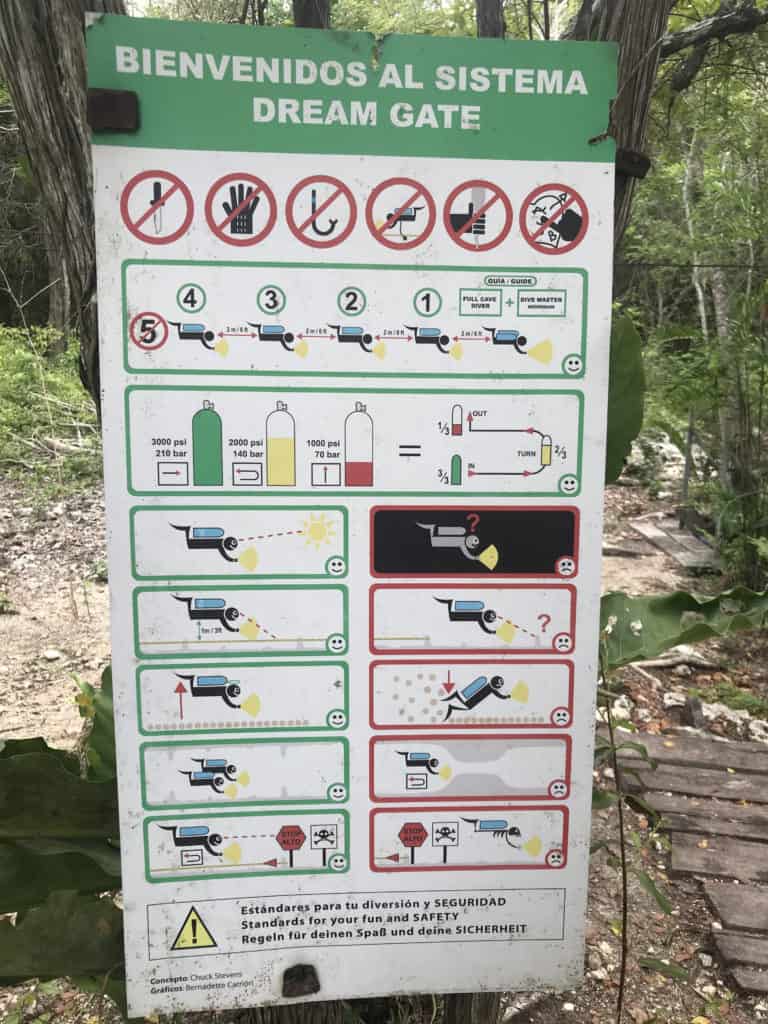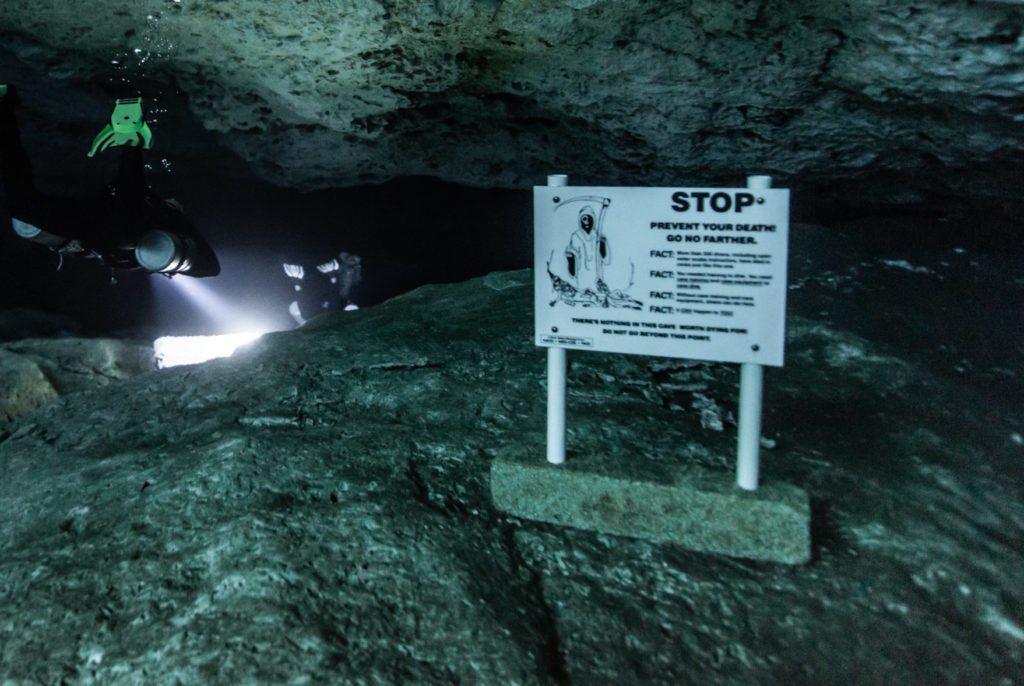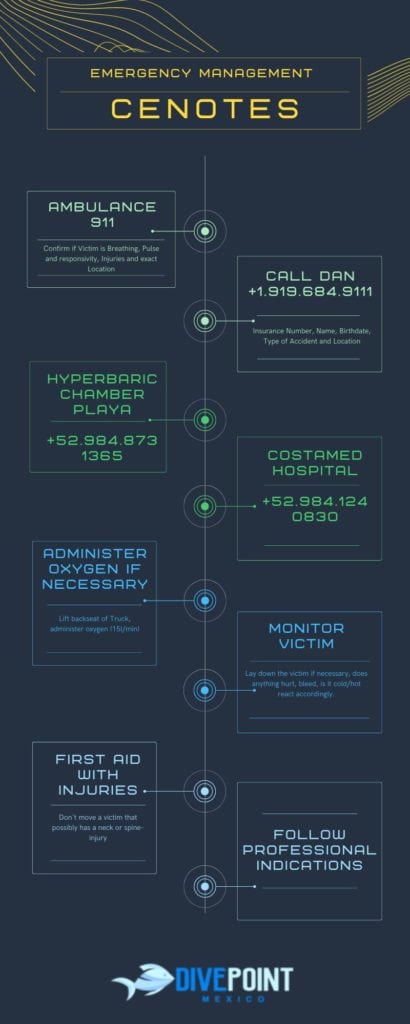Before booking their dives, many divers ask if it will be possible for them to dive Cenotes without a cavern or cave diving certification.
Following the Cenote diving rules, the answer is: Yes! It is possible.
But certainly, there are some extra rules compared to open water diving (in an ocean or lake, with direct access to the surface)
In this blog we put together the most important Cenote diving rules, diver requirements, and 3 safety considerations we always remind our divers about.
Cenote Diving Rules in Mexico
Before every Cenote dive it is mandatory to participate in the cenote pre-dive briefing with your cenote guide. There are some rules apart from the standard open-water diving rules that all divers have to follow when participating in any cenote diving activity.
Cenote diving rules evolved from cavern diving and overhead diving protocols. They apply to all cenote dives to make cenote diving with certified professional dive guides safe and accessible for recreational divers.
Before starting your dive ensure you understand the briefing and clarify any doubts for everyone to enjoy their dive!

NO Knives, Gloves, Snorkels, Unsecured Gear
Ensure you only bring allowed equipment into the cavern during the dive. Following Cenote diving safety rules we’re not allowed to take knives, gloves, or snorkels, and all diving equipment, hoses, and accessories have to be secured, attached, and streamlined throughout the dive.
NO Touching of Speleothems, Sediment, or Any Part of The Cavern
Touching or breaking speleothems, or manipulating the cave and cavern, is considered a federal crime and has to be reported. Similar to the no-touching rule we abide to while reef-diving!
Sequence and Maximum Group Size
The maximum group size of 4 divers per Cenote dive guide is standard in most of the Cenotes. Some Cenotes require an even smaller ratio of divers per guide due to the complexity of the dive.
Divers dive in a single file setup, with the Cenote dive guide leading the group at all times.
Gas Limits: Rule of Thirds
Because we dive in a so-called overhead environment, we can’t just breathe our tanks down to 50 bar and ascend to the surface. During Cenote dives we apply the rule of thirds.
⅓ of our full tank (full tank = 210 bar or 3000 psi) to dive into the cavern, ⅓ to dive out of the cavern, and ⅓ stays in the tank as a mandatory reserve.
If we dive a Cenote line that is rather a loop, there is usually a marker on the guideline at the mid-point of the dive. We turn around when the first diver reaches 2/3 gas supply in case we have not reached the marked mid-point yet.
No Cave Diving
Cenote diving rules strictly prohibit cave diving during guided recreational Cenote dives.
We stay in the cavern diving zone of the Cenote, which allows direct visible access to daylight when diving lights are covered.
Follow The Guideline
This is one of the 5 golden rules of cavern & cave diving.
We have to dive along a Cenote diving guideline at all times when in the overhead environment. This part of the dive does not allow vertical access to the surface and requires us to dive out horizontally before reaching the surface. Cenote diving safety rules prohibit diving off the guidelines.
While always maintaining visual contact with the guideline, it’s important to be aware not to grab or entangle with it. We are not allowed to dive further off the line than 1 meter.
Neutral Buoyancy & Proper Propulsion
While diving in Cenotes we are required to protect the fragile underwater environment by maintaining neutral buoyancy throughout the dive. Therefore it’s important to be properly weighted and make a buoyancy check before entering the cavern.
Throughout the Cenote dive, we should be careful with our fins, to not touch or kick the formations, sediment, or guidelines. To achieve this, your Cenote dive guide will explain to you the proper propulsion and finning techniques to preserve the environment during your dive.
No Restrictions
Restrictions in a cavern or cave are considered tunnels, obstructed areas, or similar that do not allow two divers to pass through in a gas-sharing or emergency exit scenario comfortably.
Every Cenote dive leads through wider tunnels, spacious areas, and not-so-complex dive profiles to ensure your safety.
No Diving Beyond STOP-Signs
Many Cenotes and cave systems have their cavern zone strictly limited by a STOP Sign. During Cenote diving tours we are prohibited from diving beyond these signs and the cavern diving guidelines never pass into the prohibited zone.

Requirements for SCUBA Diving in Cenotes
Minimum Open Water Diver Certified
To book a tour to Cenotes in Tulum for diving you have to be at least a certified open water diver.
Local regulations and SCUBA associations rules and standards state that no uncertified diver can enter the ‘overhead environment’, which is what we do while diving Cenotes.
Some Cenotes even require divers to be Advanced Open Water certified
Minimum 15 Years Old
Any diver joining a dive in Cenotes in Mexico has to be at least 15 years old, as stated by Cenote diving rules and applied in all Cenotes.
Divers between 15-18 years of age are required by some Cenotes in Tulum to be accompanied by a parent instead of only a guide.
Minimum 10 Dives Total + Checkout Dive
All participants who wish to dive in Cenotes near Tulum are required to have at least 10 previous dives completed and have to complete a checkout dive before entering the overhead environment and Cenote dive.
Maximum Group Size of 4 Divers per Guide or Less
No group size can exceed the number of 4 divers per certified guide during cenote dives in Tulum and the Riviera Maya.
Some more advanced or deeper Cenotes even require to size down groups to 3 or even 2 divers maximum per guide. Examples are Cenote Zapote, Maravilla and Tak Be Ha.
3 Safety Considerations when Diving Cenotes in Mexico:
1. Always Dive Cenotes with a Certified Guide
Cenote diving requires specialized training and knowledge due to the unique challenges posed by underwater caves and so-called overhead environment diving.
Always dive with a certified guide who is familiar with the cenote’s layout and potential hazards to guarantee you a safe Cenote diving experience.
Most incidents during dives in Cenotes happen mainly because divers decide to dive on their own, unfamiliar with the dive sites, without a guide and proper training or equipment required to execute the planned cavern dive.
Nowadays Cenotes won’t permit divers access if they arrive without a certified Cenote diving guide registered with the respective Cenote.
2. Follow The Guide’s Cenote Dive Briefing
Cenote Diving rules are different from the day-to-day ocean dives and more strict regarding planning, gas supply, and conservatism.
- Always follow the line.
- Stay close to your guide. Never separate from the group.
- Do not exceed ⅓ of your gas supply to dive into the Cenote.
- If you take a GoPro or camera on your dive, ensure your attention is always on the group and never only focus on your camera.
Be aware that most Cenotes are private property and the owners can have extra rules in place such as not allowing cameras on their property or requiring underage divers to be accompanied by a parent + certified guide rather than just a cenote guide.
3. Maintain Proper Buoyancy and Monitor Your Air Supply:
Cenotes often feature rock formations and delicate ecosystems. To protect the environment and ensure your safety, maintain proper buoyancy control and avoid touching the walls or formations.
Breaking or even taking parts out of the Cenote is a federal crime and handled as such.
Cenote diving can be physically demanding, time flies underwater and so does your air supply. Keep a close eye on your SPG throughout the dives and plan to ensure a safe ascend with an adequate reserve of at least ⅓ of your total gas supply, according to Cenote diving rules.
Emergency Protocols for Cenote Diving

Certain protocols have to be followed for any diving incident, including Cenote diving.
(The only situation in which different procedures are followed, is when a cave rescue becomes necessary to secure a trapped diver’s integrity, or in the worst case perform a body recovery after a fatality following a cave diving accident)
In order to avoid any incident underwater, it’s of utmost importance to correctly execute all pre-dive gear-, and buddy-checks before entering the water to dive.
Not quite sure if you remember to do a buddy check. Read our guide on how to perform a dive buddy check before your next dive!
Is SCUBA Diving in a Cenote Cave Diving?
Simply said: No.
For Cave Diving you need special cave diving training and certification.
Per Cenote diving rules, recreational Cenote diving is guided cavern diving, so we only dive in the entry area of the cave far from tiny tunnels and dark, unvisited places, and always in the daylight-accessible area along the guideline.
Per definition, the cavern consists of the entry area of a cave, where there is still visible natural light upon covering the dive lights every diver is required to carry during his Cenote dive.
Many Cenotes offer beautiful light-filled areas during the dives, connected by darker, wide tunnels like Dos Ojos Cenotes in Tulum.
SAFE CENOTE DIVING WITH DIVEPOINT MEXICO
Here at DivePoint Mexico we certainly follow all cenote diving rules during our tours and ensure you have no more questions or doubts before entering the water. Our focus priority for any diving activities is safety for our divers and instructors.
Join our daily trips to Cenotes and enjoy a safe cenote diving experience in the Mexican Riviera Maya.
We require divers to do a checkout dive before cavern diving, to guarantee everyone’s safety and enjoyment during the dives.
We hope you enjoyed reading this blog post about “Cenote Diving Rules & Cenote Safety”
Contact us to go diving in Cenotes or check out our diving packages!
Stay up to date reading our other interesting blog topics & follow us on our Facebook and Instagram pages.


